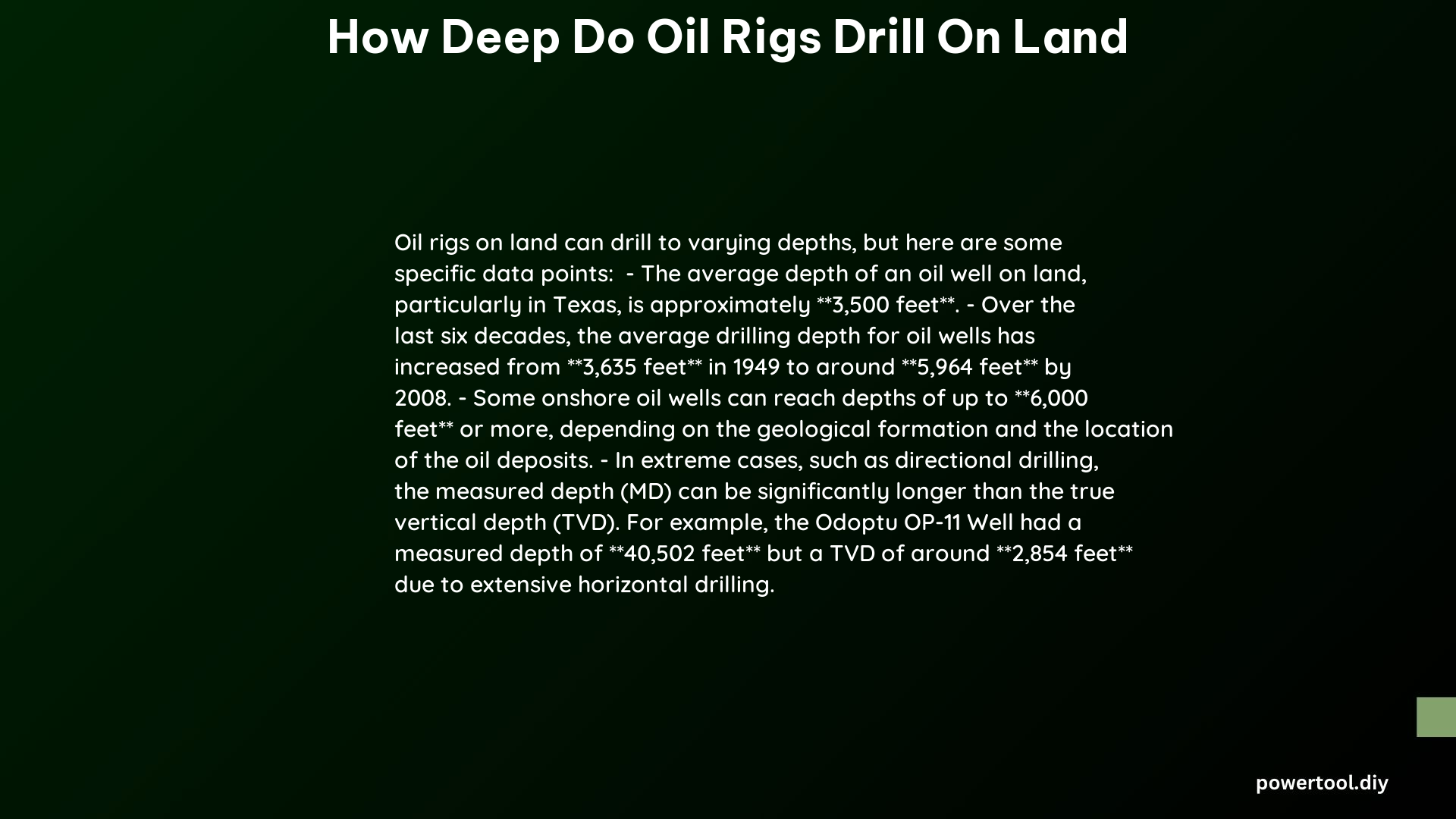Land-based oil rigs typically drill to depths ranging from 5,000 to 20,000 feet, with some reaching up to 30,000 feet or more. The average depth has been increasing over time, driven by the need to access deeper reserves as shallower ones are depleted. Factors such as geological formations, drilling technology advancements, and economic considerations influence the drilling depth. This article explores the intricacies of land-based oil rig drilling depths and their implications.
What is the Average Depth of Land Oil Rigs?
Land-based oil rigs generally drill to depths between 5,000 and 20,000 feet. The average depth has been steadily increasing over the years as more accessible shallow reserves are exhausted. For instance:
- In 2008, the average depth of oil wells was approximately 5,964 feet
- By 2020, many wells were routinely drilled to depths exceeding 10,000 feet
This trend reflects the industry’s push to access deeper, more challenging oil and gas reserves to meet global energy demands.
What is the Maximum Depth Achieved by Land Oil Rigs?

While the average depth is significant, some land-based oil rigs have achieved remarkable maximum depths:
- Deep wells in the United States are classified as those drilled deeper than 15,000 feet
- Some of the deepest oil wells on land have reached depths of up to 30,000 feet or more
- A notable example is a well that reached a depth of 31,441 feet
These ultra-deep wells represent the cutting edge of drilling technology and engineering capabilities.
What Factors Affect Oil Rig Drilling Depth?
Several key factors influence how deep oil rigs drill on land:
- Geological Formations
- Oil and gas reserves are often found in specific rock formations
- 75% of oil wells deeper than 15,000 feet in the U.S. produce from clastic rocks
-
The depth and characteristics of these formations dictate drilling depths
-
Drilling Technology
- Advancements enable access to previously unreachable reserves
-
Technologies include:
- Directional drilling
- Extended-reach drilling
- Hydraulic fracturing
- Automated drilling systems
- Remote monitoring
- Digital twin technology
-
Economic Considerations
- Drilling costs increase significantly with depth
- Deeper wells often yield higher returns, justifying increased expenses
- Factors considered include:
- Expected reservoir properties
- Pressure
- Flow rate
- Fluid composition
How Does the Drilling Process Work at Great Depths?
The drilling process for deep oil wells involves several complex steps:
- Borehole Creation
- Rotating drill bit creates the borehole
- Drilling mud cools the bit and removes cuttings
-
Mud also maintains wellbore integrity
-
Casing Installation
- Steel casing pipes inserted to stabilize the formation
-
Protects groundwater and prevents collapse
-
Well Completion
- Cement injected between casing and surrounding rock
- Creates a secure seal for structural integrity
-
Prevents leakage and contamination
-
Performance Monitoring
- Rate of Penetration (ROP) measures drilling speed
- Logging While Drilling (LWD) provides real-time subsurface data
- Measurement While Drilling (MWD) optimizes drilling trajectories
What are the Costs and Schedules for Deep Oil Drilling?
Drilling deep oil wells involves significant costs and time commitments:
| Depth (feet) | Relative Cost | Approximate Schedule |
|---|---|---|
| 5,000 | Base cost | 1-2 months |
| 10,000 | 2-3x base | 2-4 months |
| 20,000 | 5-10x base | 6-12 months |
| 30,000+ | 10-20x base | 12+ months |
Factors affecting costs and schedules include:
– Specialized equipment requirements
– Higher operational costs at greater depths
– Complex well designs
– Rigorous testing and safety protocols
How Do Performance Metrics Change with Depth?
As drilling depth increases, various performance metrics are affected:
- Drilling Efficiency
- Generally decreases with depth due to increased complexity
-
Advanced technologies help maintain efficiency
-
Well Completion Rates
- Typically slower for deeper wells
-
Require more time for proper sealing and testing
-
Production Rates
- Can be higher for deeper wells due to greater reservoir pressure
-
May decline more rapidly over time
-
Safety Considerations
- Increase with depth due to higher pressures and temperatures
- Require more sophisticated monitoring and control systems
By understanding these factors and metrics, oil companies can optimize their drilling operations and maximize the potential of deep oil reserves on land.
